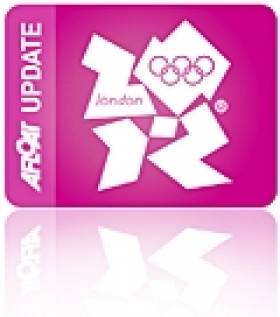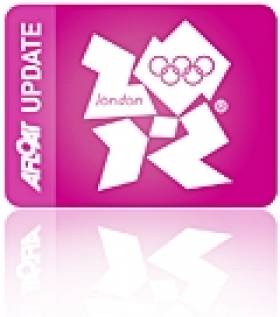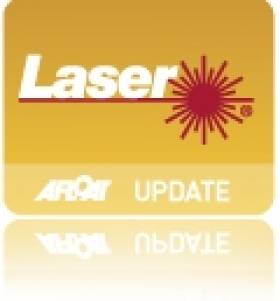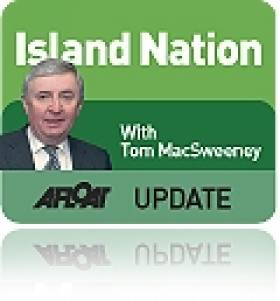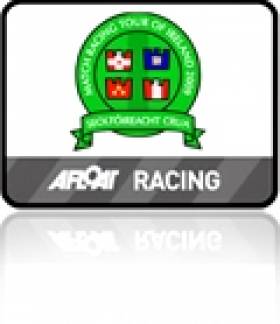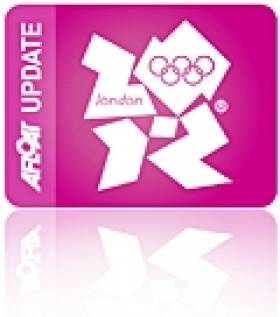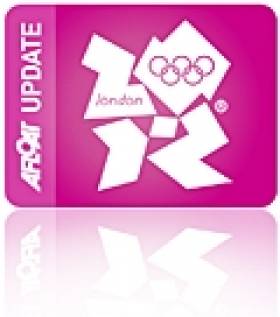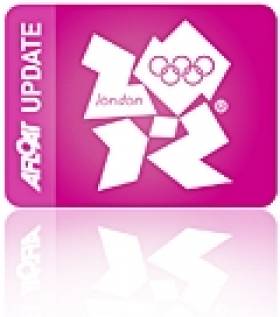Displaying items by tag: Weymouth
Irish Sailors Prepare for Second Leg of Olympic Trials
The promising results from Holland included Peter O'Leary and David Burrows who were fourth overall in the Star class. Annalise Murphy was ninth overall in the Laser Radial and Ryan Seaton and Matt McGovern were fifth overall in the 49er dinghy.
Podcast with Olympic team manager James O'Callaghan
755 Entries, 62 nations, 1072 athletes, 320 coaches this is the biggest sailing world cup regatta ever. Every sailor with Olympic ambition is targeting a performance this week on the Olympic waters.The Irish sailors are no different but have the extra incentive of knowing the event counts as selection for the Irish Olympic team. Last week at the World Cup in Holland, the Irish Sailing squad performed: all made the Medal race final and both the Radial and the 49er won the Medal race. This week will be a step up in standard with the majority of countries using this event to assess their sailors Olympic potential.
In the Star class Peter O'Leary and David Burrows will be hoping to defend the title O'Leary won last year, Annalise Murphy will be targeting another medal race final and Ryan Seaton and Matt McGovern would be pleased with another top performance.
Olympic Crews Heading for 'Sail for Gold' Regatta
After last weekend's Sailing World Cup Regatta in Medemblik, Holland the Irish Olympic sailing squad is back on the water in five days time for the next round of the Cup, this time at the 2012 Olympic venue itself and the Skandia 'Sail for Gold' Regatta in Weymouth.
Expectations are high that Ireland can be in the medals in England not least because Ireland qualifed for three medal races last week and last year Peter O'Leary won Gold in the Star class in Weymouth.
Over 1,000 sailors, including a number of World and Olympic champions, will be competing in Weymouth, Great Britain, the venue of the London 2012 Olympic Sailing Competition.
Great Britain's Ben Ainslie, Giles Scott and Ed Wright have dominated the Finn class during the 2010-2011 ISAF Sailing World Cup.
The British trio have been at the top of the podium on every occasion. Ainslie won Sail Melbourne, Trofeo S.A.R. Princess Sofia MAPFRE and the Semaine Olympique Française, Scott won US SAILING's Rolex Miami OCR and Wright won the Delta Lloyd Regatta last week.
But it is Ainslie who leads the Finn Standings on 79 points ahead of Scott, on 71, and Wright on 66. All three will sail in Weymouth alongside some equally impressive sailors in the form of the World #1 Ivan Kljakovic Gaspic (CRO), World #2 Zach Railey and Spain's Rafael Trujillo.
However it is hard to see anyone defeating the Brits who have dominated the class since the inaugural ISAF Sailing World Cup in 2008-2009 which has seen Wright crowned ISAF Sailing World Cup Finn Champion on two occasions.
Mathew Belcher and Malcolm Page (AUS) reclaimed the top spot in the Men's 470 Standings after clinching gold at the Delta Lloyd Regatta. The World #1 Australians have a 17 point lead over Panagiotis Kambouridis and Efstathios Papadopoulos (GRE) in second. World #5 sailors Pierre Leboucher and Vincent Garos (FRA) trail the Australians by 18 points in third.
The top three will all sail in Weymouth but it is a tough ask for anyone to overhaul Belcher and Page who have a strong lead with just two ISAF Sailing World Cup Regattas remaining.
Eight points separate the top five in the Women's 470 ISAF Sailing World Cup Standings.
Despite not sailing in Medemblik, Penny Clark and Katrina Hughes (GBR) retained their lead at the top of the Standings on 54 points. But Delta Lloyd Regatta runners up Ai Kondo and Wakako Tabata (JPN) trail the Brits by three points and will look to make up the ground on the World #3 pair at Skandia Sail for Gold.
Marit Bouwmeester (NED) and Evi Van Acker (BEL) are tied at the top of the Laser Radial Standings on 69 points each. They will renew their rivalry in Weymouth but with the top ten in the Standings all set to compete, and the third place Veronika Fenclova (CZE) within touching distance of the leaders the gold medal is far from a foregone conclusion.
The 2011 Skandia Sail for Gold Regatta will also welcome the top ten in the Laser Standings. The standout performer this year has been Tom Slingsby (AUS) who has been on the podium in the four ISAF Sailing World Cup Regattas he has sailed in. He has a 14 point lead over Javier Hernandez (ESP) in second and a 20 point lead over Nick Thompson (GBR) in third.
In the Paralympic classes the top three in the 2.4mR, SKUD-18 and Sonar ISAF Sailing World Cup Standings will compete.
Racing begins at the 2011 Skandia Sail for Gold on 6 June and will run until 11 June.
Do Some Funny Sailing for Comic Relief
In Weymouth, SailLaser's RYA Onboard Club are invited to teach a friend to sail in a Laser Pico before heading off to the race course in pairs. The race around a short course will have the added challenge of collecting as many letters from each turning mark as possible. The winners will be those who can spell the longest word from the letters they collect at the end of the race!
SailLaser's "Race Club" members will also be able to introduce a friend to sailing and after a short introduction they will battle it out on the race course in the fleet of Laser Bahias.
In Scotland, RYA OnBoard Club fund raisers will take part in a multi-disciplined "Tri-Mile" event. The Tri-Mile will include a run, pedal and sail; running from the start line to a pedalo on the shore, pedalling to a Pico moored in the middle of Strathclyde Loch and racing the Pico around a course before arriving back at the shore and running to the finish line!
To add to the fun, competitors, organizers and helpers are encouraged to wear fancy dress. The theme is RED!
"This is a great opportunity for all of our regular sailors to get on the water with a friend as well as raising money for Comic Relief" explains Hannah Burywood, event organiser at SailLaser Weymouth.
The charity Comic Relief was launched on Christmas Day in 1985 from a refugee camp in Sudan. The highlight of Comic Relief's appeal is the bi-annual Red Nose Day. The first Red Nose Day was held in 1988 and £15 million was raised. In 2009, over 5 times that amount was raised to support projects in 25 African countries and the UK. SailLaser is proud to do their bit to support Comic Relief in 2011.
Would You Pay to Watch Sailing?
There are those who don't like sailing – and even some in the sport itself – who have described watching a sailing race as "about as interesting as watching paint dry. While exciting pictures have been available from the Volvo Round the World Race and match racing has proved watchable, these were exceptional highlights compared with the more mundane aspects of yacht racing. Raising public interest in the sport has been a permanent difficulty.
The Olympic Games have fared no better. The last Olympics in China were difficult for sailing where the racing was not regarded as of sufficiently high quality, courses were perceived as often poor and there were even difficulties in finding enough clear water at times due to silting and other problems.
With tickets due to go on sail in two month's time for the London Olympic Games in 2012, controversy is flaring over a decision to impose charges to watch sailing.
The 2012 Games will be the first in Olympic history to charge spectators for sailing races, with temporary seating being provided for up to 4,600 paying customers at Weymouth's Nothe Gardens, a local beauty spot which overlooks one of the racing areas at Newton's Cove. Weymouth and Portland Council received official notification about the plan a week before Christmas. This was more than two months after the London organising committee, Locog, announced ticket prices for the Games, including sailing.
The spectator experience at previous Games has been confined to a glimpse of sails through a pair of binoculars, but by bringing the action close to shore, Locog believes it can turn sailing into an exciting spectator sport.
They are hoping that ticket sales will be encouraged by the introduction of new events such as women's match-racing — a series of 20-minute head-to-head races between two boats. This will begin with a round-robin phase before turning into a knockout competition and is intended to form the core of the programme on the Nothe course. It will be supplemented by races involving two of what are regarded as spectacular classes - including the 49ers and the windsurfers.
In the second week of the Games, the course will play host to the final medal races in all boat classes.
This concept of bringing the sport to the fans onshore has the full backing of the International Sailing Federation, which will be hoping for capacity crowds in the temporary stands, where spectators will be asked to pay up to stg£55 each to watch the sailing.
However, local people in Weymouth and Portland are angered by the intention to turn their public park into a ticketed venue. The Council has accused the organisers of not discussing their plans in advance and local councillors claim people are outraged that they will be barred from the park for several weeks.
Locog has defended its decision to sell tickets, saying that, for the first time, sailing will be presented as a true onshore spectator experience, which the International Sailing Federation is keen to develop. The organisers also cite safety concerns, with a ticketed venue allowing them to predict crowd numbers. They insist the move is not motivated by financial gain, but that is, clearly, being questioned.
For those unwilling to pay, there will still be one or two free vantage points near Newton's Cove as well a free site with a big video screen and stage on Weymouth Beach.
Sailing competitions will take place on five courses but only at Newton's Cove will spectators be able to watch from land with the naked eye. Tickets, which will go on sale in March, will range from stg£20 for preliminary races to stg£55 for medal races. Discounts will be offered for children and over-60s.
Locog said councillors were invited to a meeting about Nothe Gardens in October. It added that there would be a public consultation later this year prior to submitting a formal planning application for the use of the park for charged viewing. It will be interesting to see how the Council reacts to that application!
One thing the controversy is doing is, at least, is to highlight the sailing events!
• An interesting sidelight about public interest in sailing is that, while sailing has difficulty in getting television coverage, a total of 506,000 people watched USA TV personality, Oprah Winfrey and the star of the film, 'Master and Commander,' Russell Crowe when they presented a sailing programme from Sydney Harbour.
- This article is reprinted by permission of the EVENING ECHO newspaper, Cork, where Tom MacSweeney writes maritime columns twice weekly. Evening Echo website: www.eecho.ie
Bid to Hold Women's Match Racing Event on Belfast Lough
In a further boost for the fledgling match racing scene here, top Irish international Umpire Bill O'Hara is looking to have the ISAF Grade one women's match racing event held on Belfast Lough from his home port of Bangor from August 17 - 20 2011, straight after the Weymouth pre-Olympic event.
Ireland Guaranteed Medal in the Star Class Today (Podcast here)
Ireland is guaranteed a medal today at the British Skandia Sail for Gold regatta in the Star class but Peter O'Leary's clean run in the keelboat this week was not without drama yesterday when his crew Fritjof Kleen slipped overboard 300 metres from the finish line.
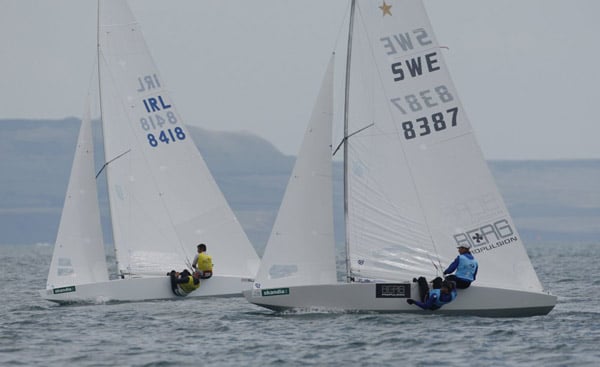
Peter O'Leary and Frithjof Kleen (IRL) against Fredrik Loof and Johan Tillannder (SWE) in the Star class on day 5 of the Skandia Sail for Gold Regatta. Photo: onEdition
Big Breeze Brings Big Results in Weymouth
Peter O'Leary and newly adopted German crew Frithjof Kleen were winners in the single Star keelboat race today but only after an international jury granted redress to the Cork helmsman who crossed the line second at the Skandia Sail for Gold regatta in Weymouth this afternoon. A second win for Ireland was secured in the big breeze by Annalise Murphy in the Laser Radial class who also scored second in this morning's race, rounding off a successful day for the 11 strong Irish crew off the Portland Bill. Below is a podcast update from Team Manager James O'Callaghan as the crews came off the water this evening.
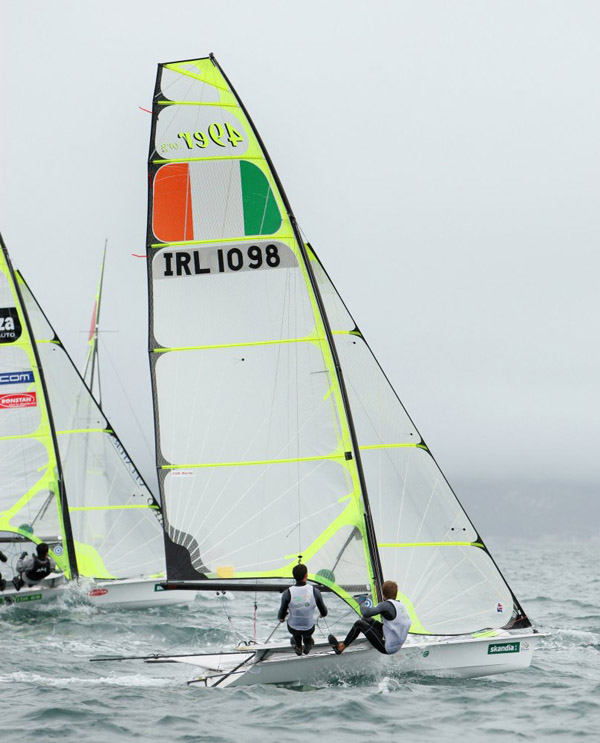
(Above) Ed Butler and Ben Lynch (IRL) in action in the 49er class on day 2 of the Skandia Sail for Gold Regatta and (below) Saskia Tidey in the Laser Radial . Photo OnEdition
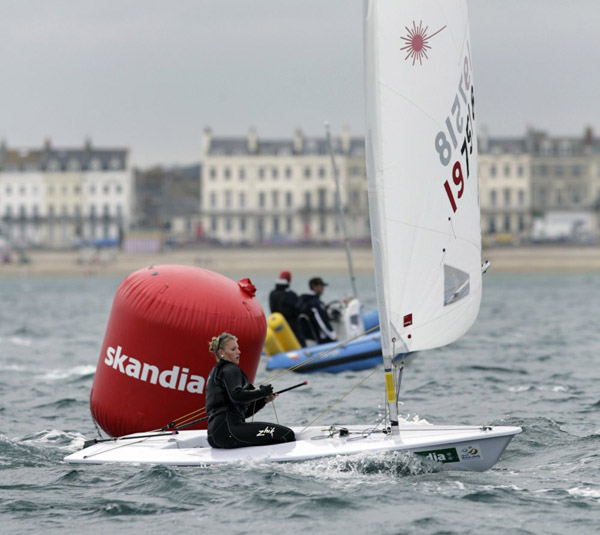
Irish Olympic Stars in Action in Weymouth
The clearest indication of Irish sailing form for the 2012 Olympics will be known this week when four Sports council carded sailors go into action in a massive regatta of 800 sailors at the Skandia Sail for Gold Regatta in Weymouth. Annalise Murphy is in the Laser Radial and in the Star class Max Treacy and Anthony Shanks go head to head with Peter O'Leary who the Irish Times says this morning has had a last mniute crew change. David Burrows is out and Germany's Frithjof Kleen is sailing as a late substitution.
If you took a wander around the fine old English seaside resort of Weymouth, you'd find a mix of motives for being there on this particular Sunday in August – the beach, the sea, the ice cream. Move round the bay a little to the Weymouth and Portland National Sailing Academy, where the elite of Olympic sailing are gathered for Skandia Sail for Gold 2010, and you'd think that the replies would be a little more focused – winning, perhaps? But you'd be wrong...
It might be the final event of this year's ISAF Sailing World Cup, not to mention the last but one Olympic class regatta at the 2012 venue before the main event, but not everyone is necessarily here to win. The Dutch 470 sailors, Lisa Westerhof and Lobke Berkhort have racked up five 470 World Championship titles between them, including the most recent, along with Olympic silver in Beijing for Lobke. But when Lisa was asked if they had a choice between going left on the race course to stay with their competition, and going right to learn more about the venue, she replied, "We might choose the right, but we'll have to see," adding with a laugh, "It's nice to have a good result, we're sportsmen, we like to win."
Lisa and Lobke are out of contention for the ISAF Sailing World Cup, but Emmanuelle Rol and Hélène Defrance are just one point behind their French compatriots overall, Ingrid Petitjean and Nadège Douroux. But Rol reckons they have a weakness in breezier conditions after a poor performance at the World Championships, and is hoping to establish that they have improved after training in the Mistral in Marseille, "For us, the result is important, but also to try to have good races in strong conditions, and of course, learn about the Olympic venue. And so far, we have learned that the weather is not as good as in Marseille." The last said, we're sure, purely in jest...
US Sailing Team AlphaGraphics meteorologist (and former holder of the same position for the Luna Rossa America's Cup team), Doug Charko reckoned that Rol and Defrance will have plenty of opportunity to check their heavy weather progress, "There's a low heading into the area, which will probably arrive for Tuesday. So ten to 15 knots for Monday, building during the day, and then Tuesday with the low passing over Scotland there's quite a wide range in the global models, so although I'm hedging my bets a little, I'd say 15 to 20 and gusting to 25 knots from the south-west, raining and unsettled." Things look a little better for the rest of the week, with moderate south-westerly sea breezes forecast – classic Weymouth conditions.
Another Women's 470 contender who theoretically doesn't need to learn much about the venue is double Olympic Yngling Gold medallist and Weymouth resident Sarah Ayton. After recently returning to sailing following the birth of her first child, Ayton and her crew Saskia Clark is not in contention for the overall ISAF Sailing World Cup. But Sarah nevertheless finds herself with a similar balancing act; "You've got to use the opportunity to learn, you don't get many opportunities with a world class fleet in this venue, so it is important to learn. But obviously, it is important to perform in the Olympic venue, so it is a real balancing act of trying things when you can, but bearing in mind the end results." When asked the left or right-side of the course question, she replied with a smile, "It would be hard not to stay with the competition."
Sarah was up on the stage for a very bling opening ceremony, the new Olympic venue dripping with medals two years early. Many of those present are sailing in the Star class, which has some serious star-wattage. Double Olympic-medallist and current Star World Champions, Iain Percy and Andrew Simpson had come straight from Team origin's win over current America's Cup holders, BMW Oracle, in the 1851 Cup.
For Iain Percy, it was a chance to learn about the venue, reckoning that they had to look at each Olympic venue afresh, in a much more analytical, professional way. But there were other reasons for coming to Weymouth, "Myself and Andrew do a lot of other sailing, and whenever we get back in the Star we always have a really good time, relax and enjoy it, old mates going out for a sail. So whenever we get a bit of a window in the calendar we jump at trying to get out in the Star for a bit of fun, and that's the main reason we're here."
Further Quotes
Lisa Westerhof (Holland, Women's 470, current World Champions), on their priorities for Skandia Sail for Gold; "We do set priorities during the year and our main goal this year was the World Championships. We use the World Cup to work with our processes and to develop equipment. We'll use this week to get to know the conditions in Weymouth and to get a feel for the water and the sailing conditions. But the weather and the systems - the low pressure and high pressure weather systems - the variety in the weather is comparable to Holland, so we feel at home."
Emmanuelle Rol (France, Women's 470, currently second in ISAF Sailing World Cup), on their priorities for Skandia Sail for Gold; "We are using the same equipment here as at the Worlds - developing gear will be the winter's task, we will try some new stuff then. We are quite a new crew together, so we had to work out our team work, and our next job will be to work on the equipment."
Iain Percy (Britain, Star, current World Champion), on the topic of keeping current with Olympic sailing, while balancing it with other sailing commitments; "I tried a little experiment after 2000 with the Finn, when I used to go back and have a race against the guys - and after nine months I felt pretty good, but then when I went back and tried it a couple of years later I was absolutely hopeless. So somewhere between your brain and your hands there's a memory that runs out after a certain amount of time."


























